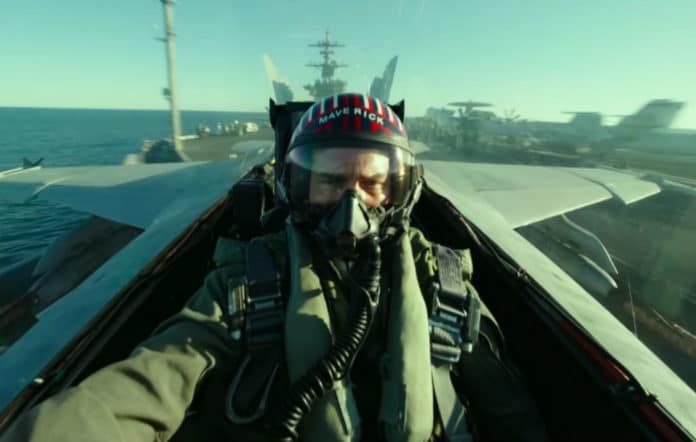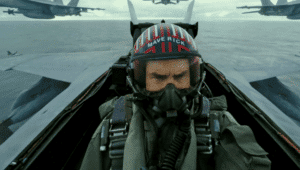Aerospace
How did Top Gun shoot the movie in a US Navy fighter jet, and how much did it cost?

Top Gun Maverick is currently playing in theatres, and tome Cruise, who is famed for his amazing stunts and action, plays the lead part in this picture. The film was scheduled to be released in 2018, however it was postponed due to the epidemic. Another feature of the film is the F/A 18 fighter jet, which is now serving in the US Navy.
It was difficult to shoot the video with the F/A 18 since the US Pentagon has prohibited the use of defense assets for non-military purposes. The film’s creation has cost a fortune in order to persuade the US Pentagon.
To be able to replicate in the film reel, the Top Gun team has gone through intensive training. In essence, they underwent deep water training in the event of an emergency and received basic instruction in the L-39 aircraft. Since the F/A 18 is the fastest fighter jet, it possesses a high G force. The cast and crew have put forth a lot of effort to get that serious expression in the performing.
Tom Cruise was given F/A-18 Super Hornets by the US Navy for the next “Top Gun” film. The only catch: the studio paid up to $11,374 per hour to use the powerful fighter planes, and Cruise was not allowed to operate them.
The “Mission Impossible” star, who is known for executing his own stunts, requested that all of the actors playing pilots in the long-awaited “Top Gun: Maverick” picture fly in one of Boeing Co.’s fighter jets to get a sense for what it’s like to fly under the strain of massive gravitational forces.
Airbus demonstrates first fully automatic vision-based take-off
Cruise, 59, had previously flown in a jet for the 1986 smash hit “Top Gun.” According to Glen Roberts, the chief of the Pentagon’s entertainment media office, a Pentagon law prohibits non-military persons from managing a Defense Department equipment other than small weapons in training scenarios. Cruise flew more than a dozen sorties for the new film. Instead, after completing essential training on how to eject from the jet in an emergency and how to survive at sea, the actors rode alongside F/A-18 pilots.
Cruise established his own tough flight training programme for the film’s teenage actors, according to production notes, so that they could survive the nausea-inducing rigours of aerial maneuver’s and execute their roles with “actual Navy pilots taking them on the ride of their lives.”
Facts Pilots Don’t Want You To Know…!!
After being delayed owing to the coronavirus outbreak, the film is finally being released this week. According to Roberts, the scenes were shot onboard the USS Abraham Lincoln during a training exercise with the military’s F-35C Lightning II fighter plane in August 2018. In Central California, the project also filmed at Naval Air Station Lemoore.
The film is doing well over the world, and it is expected to break all box office records. It’s a coincidence that the picture came out right before the Indian Navy’s contract negotiations. There will be less of a political game to decipher the intent, but enjoy the film nonetheless. Tell us whether you saw the movie and what you thought of it in the comments area.
Why is China concerned about the Ka 52 being shot down?

Aerospace
Boeing Transfers Rocket Stage to NASA, Paving Way for Human Moon Mission

Boeing has achieved a significant milestone by providing NASA with the second core stage of the Space Launch System (SLS) rocket.
This crucial component, crafted at NASA’s Michoud Assembly Facility (MAF), is set to propel the Artemis II crew into lunar orbit, marking humanity’s return to deep space after a 50-year hiatus.
The monumental Boeing-built rocket stage, the largest element of the Artemis II mission, will embark on a journey aboard the Pegasus barge, traveling 900 miles to NASA’s Kennedy Space Center.
Comparison of two legendary aircraft B777x vs B747 aircraft:Click here
Upon arrival, it will be meticulously integrated with other essential Artemis II components, including the upper stage, solid rocket boosters, and NASA’s Orion spacecraft within the iconic Vehicle Assembly Building. This intricate integration process is a vital step toward the eagerly anticipated Artemis II launch, slated for 2025.
“Boeing-built products helped land humankind on the moon in 1969, and we’re proud to continue that legacy through the Artemis generation,” remarked Dave Dutcher, vice president and program manager for Boeing’s SLS program. “Together, with NASA and our industry partners and suppliers, we are building the world’s most capable rocket and paving the way to deep space through America’s rocket factory in New Orleans.”
NASA, Lockheed Martin Reveal X-59 Quiet Supersonic Aircraft:Click here
The delivery of Core Stage 2 marks a significant achievement in the evolution of the SLS rocket. Towering over 200 feet and powered by four RS-25 engines, this core stage, coupled with two solid-fueled booster rockets, will generate a staggering 8.8 million pounds of thrust. This immense power is crucial to launching Artemis II and future missions into the vast expanse of space.
The SLS rocket stands unparalleled in its capability to transport both crew and substantial cargo to the moon and beyond in a single launch. Its extraordinary capacity will facilitate the delivery of human-rated spacecraft, habitats, and scientific missions to destinations including the moon and Mars, ushering in a new era of space exploration.
-

 Travel1 week ago
Travel1 week agoAir India to Expand US Operations with Three New Routes After a Decade
-

 Travel2 weeks ago
Travel2 weeks agoWhy We Should Avoid These Stamps in a Passport
-

 Airlines1 month ago
Airlines1 month agoInvestigations Reveal Fake Chinese Titanium in Boeing and Airbus Jets
-

 Tech4 weeks ago
Tech4 weeks agoChina’s CATL Plans 1,800-Mile Electric Plane Launch by 2027
-

 Airport3 days ago
Airport3 days agoTop 10 Largest Airports in the World by Size
-

 Aerospace4 weeks ago
Aerospace4 weeks agoChina’s Fighter Jets Turn Wings into Autonomous Drones
-

 Airlines4 days ago
Airlines4 days agoAir India Rolls Out A350s for Delhi-New York JFK and Newark Routes
-

 Defence3 weeks ago
Defence3 weeks agoBoeing Enhances Chinook with New Engines and Block II Upgrades at $96 Million








